Automatic Turnstile Gates: What Are They?
Automatic turnstile gates are mechanical barriers that only allow one person to enter at a time. Rotating horizontal arms attached to a vertical pole make up a turnstile gate, often known as a “baffle gate.” These extremely gate turnstiles are usually employed to block access to individuals who input a coin, ticket, or pass of some sort, or to strengthen a one-way flow of traffic.
Allowing only one person to pass through at a time is the most fundamental and essential function of an automatic gate turnstile, which makes it perfect for high-security areas. A physical turnstile barrier (such as a tripod, speed gate/speed lane, swing gate, or portal) coupled with an electronic access control system is the standard component of an entrance turnstile.
They are intended to regulate entrance to a building, room, or space, frequently requiring money or some other kind of authority. By guaranteeing that only one person may enter at a time, these access control turnstiles are essential for controlling pedestrian traffic and site security. Automated turnstiles are primarily used for controlling who may enter and when, creating a controlled atmosphere for different situations.
Applications for automatic turnstile barrier gates are many and include government buildings, commercial structures, sports and entertainment events, public transit hubs, and any other place where regulated access is required to protect people and property.
What are automatic turnstile gates used for?
Frequently seen in sports stadiums, office buildings, train station, schools, and numerous other places, automatic turnstiles are an essential component of daily life. Turnstiles’ primary purpose is to assist in regulating the flow of foot traffic. They contribute significantly to public place security in addition to being useful.
The Origins of Automatic Turnstiles Gates
Automatic turnstile gates were initially installed in stores by Clarence Saunders, the founder of the Piggly Wiggly chain of supermarkets in the early 20th century, to assist prevent congestion and mass panic when customers rushed to the first supermarket in history.
As a way to restrict and manage access and leave, the approach quickly gained popularity, and soon it was being applied in places with sizable crowds. The earliest known instance of barrier turnstiles being utilized at a sporting event in the United Kingdom occurred at Glasgow’s old Hampden Park stadium. In 1915, they were also put in place at Blackpool Pleasure Beach to assist manage the summer crowds.
The types of automatic turnstile gates

Full Height Pedestrian Turnstiles
When the highest level of security is required, full-height pedestrian turnstiles are the recommended option. These massive constructions are as tall as a typical entryway, making it hard to crawl under or climb over them, thereby prohibiting unwanted entrance. Full-height turnstiles, which are usually seven to eight feet high, are designed to endure severe industrial use and may be enhanced with features like biometric integration and bi-directional systems.
Because of their sturdy design, full-height versions are secure and long-lasting; yet, they can also create bottlenecks during moments of high traffic.

Full Height ADA Security Turnstiles
Full height ADA security turnstile allow those with disabilities to enter. Their floor-to-ceiling swinging gates are secured with string locks to keep out unwanted visitors. They are more appropriate for indoor usage in locations where heavy traffic or people in wheelchairs are likely to be present since they are broader than standard turnstiles. These may also be accompanied with a panic bar. Full-height security swing gates that comply with ADA regulations can be used as a stand-alone security measure or in conjunction with full-height turnstiles to create a highly secure system that yet permits wheelchair access.
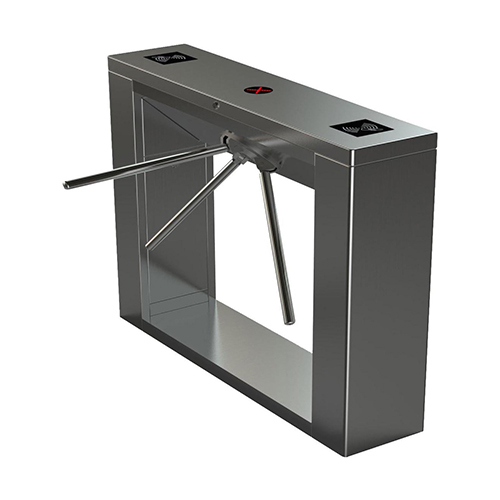
Waist High Turnstiles
Waist-high turnstiles are the more traditional type of security turnstile; they are a little less sophisticated than optical turnstiles. They use card readers frequently have doormen or security guards on hand to assist in the event that something goes wrong. They are simpler than optical turnstiles, which means they are easier to install and run and require far less maintenance.
This kind of anti-tailgating access control device can be positioned in numerous lanes for larger, busier locations or utilized as a solitary access point in small places. For the majority of uses, waist-high security turnstiles are an affordable option that may be installed both indoors and outdoors. Because of their low cost, pedestrian turnstile gates of this kind are a popular option for many different kinds of establishments. They can be used to control admission and departure, and they can integrate readers or other devices to verify credentials or tickets.
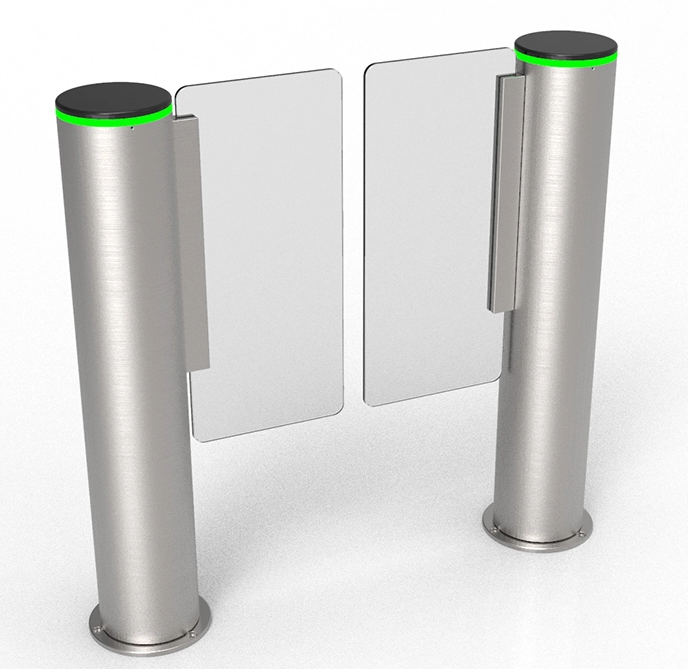
They can be employed as a stand-alone security measure or in combination with waist-high turnstiles. Accessible turnstiles are frequently seen in transit stations and are different from security turnstiles mainly in that they are hinged security swing gates, usually composed of stainless steel, or glass barriers that are fastened to a post. Because they provide more access, waist-high ADA turnstile gates are frequently utilized in locations where you wish to maintain security while permitting free passage for those with impairments or those carrying items. To comply with the Americans with Disabilities Act, automatic turnstiles must be ADA-compliant. They give guests in wheelchairs or mobility vehicles unhindered access with their hands-free access solution. Handicap turnstiles are also broader than regular turnstiles for added convenience.

Optical / Contactless turnstiles
Optical turnstiles use infrared sensors to identify individuals moving through a beam in order to regulate entrance. Users can show their credentials to a turnstile gate with a card reader connected in places where entry is restricted. The individual can use the turnstile door access control if their credentials are legitimate. Any attempt to access by someone without legitimate credentials will result in a visual or auditory warning to security.
When optical barrier turnstiles are seamlessly integrated with access control systems, security is improved without sacrificing a facility’s visual appeal. These electronic turnstiles are a great option for places that need to have a professional look in addition to effective access control. In high-volume buildings, optical turnstiles are frequently utilized to facilitate quicker entry and leave. When compared to simpler turnstiles, they are usually the most expensive.
Waist-high security turnstiles
Waist-high security turnstiles are commonly utilized at railway stations and airports,. These multipurpose waist-high devices are constructed from a single metal bar with three rotating arms that allow people to enter one at a time. As you might expect, they are mostly intended for inside usage and are waist height. They may be linked together to provide a reliable and effective multi-lane access control system that is still usable by people with impairments.
Portable turnstile gates
Similar in appearance to waist-high turnstiles, portable turnstile gates are readily and swiftly movable to locations where they are required for temporary access control. A sturdy base plate is fastened to the center post of these turnstile gate variants, and wheels are positioned beneath the base plate for convenient mobility.
When traffic volumes fluctuate, security personnel can temporarily manage crowds in areas or places without a permanent access control system by using portable access control turnstiles. When permanent barriers are not allowed in buildings or events, the devices can also be utilized as temporary access control barriers.
How are automatic turnstile gates operated?
In order to restrict access, automated turnstiles only permit one person at a time to enter designated zones before locking again to stop unwanted admission. Providing credentials, such as PINs, facial recognition, or swipe cards, allows access.
The electronic turnstile barrier stays locked in place until the correct credentials are read when a person lines up at the entry. The computer checks to see if the user has authorization to enter when they scan their credentials. The turnstile gate electronically lowers the barrier to allow entry if the user is allowed. The barrier moves back into position once they have passed through.
To regulate both access and exit, turnstile gate arms can be made to revolve in one or both directions. Although certain controlled access turnstiles, such glass swing turnstiles or speed gate turnstiles, may include doors in place of arms, they all work on the same principle: only one person with tickets or credentials at a time will be allowed entry.
Electronic control is used to operate turnstile entrance systems. The electronic turnstile locking mechanism opens to provide entry when sensors or readers detect legitimate credentials. For businesses that need a more hands-on approach to security or rely on a more stringent verification procedure for entrance, security turnstile manufacturers, including full-height turnstile manufacturers, also make variants that enable teams to operate turnstile gates manually.
What are the purposes of automatic turnstile gates?
While primarily used for crowd control, a turnstile gate can be used for a variety of other purposes:
Security: They offer an area or event a physical and visible barrier. Only authorized access by verified persons may be guaranteed by using them in combination with tickets, cards, or biometrics.
Crowd Management: Automatic turnstiles manage the movement of people in areas where big crowds must be kept under control, guaranteeing that admission is in order and avoiding congestion.
Revenue Control: In places like football stadiums or amusement parks where entry is contingent on money, security turnstiles make sure that only people who have paid the appropriate amount are allowed entry.
Data Collection: Access turnstiles may be a useful tool for gathering information about foot traffic levels when combined with contemporary technologies. Venues and facility managers may use this information to determine peak use periods and modify personnel levels and business requirements appropriately.
What Access Control Systems Are Compatible with Automatic Turnstile Gates?
Automatic turnstiles are now more than just entrance and exit points; they are advanced devices that work in unison with other access control systems thanks to technological improvements.
Card readers: While ensuring security, this can offer a quick and effective way to activate a turnstile. By encoding a card with authorized access, a person can enter by only swiping their card.
Biometric Systems: Access turnstiles can be connected to a biometric entrance system if an increased level of security is needed. The barrier turnstiles are operated by fingerprint or face recognition when using biometric entry. so that only those who are authorized can enter.
RFID Technology: Entrance turnstiles may simply be equipped with RFID readers. In other words, tags that is symbolized by badges or membership cards are successfully read by the turnstiles.
Ticket Scanners: Ticket scanners are frequently used at event locations and public transportation facilities, especially train stations. The access control systems are activated automatically by the turnstiles’ technology, which can read magnetic strips or QR codes on tickets.
CCTV Systems: Gate turnstiles may simply be equipped with CCTV systems to assist remotely regulate entry and add an additional layer of protection. When combined with turnstiles, all entry and exit points may be tracked in real time to guarantee a constant flow of foot traffic.
The benefits of automatic turnstile gates
Increased Security: Motorized turnstiles guarantee that only those who have been cleared may enter sensitive areas by enabling several authentication methods, such as PIN numbers, biometric scanning, or access cards. They reduce tailgating by erecting a physical barrier to entry, preventing unwanted access. Intruders are also visibly deterred by the turnstile door hardware.
Crowd control: Access turnstiles, which limit admission by letting only one person at a time, allow security personnel to keep an eye on and control the amount of individuals entering a facility or venue. They greatly lower the danger of unauthorized access and possible security breaches by demanding credentials for entrance.
Integration with other security systems: Turnstile gate access systems can be connected to a number of security systems, such as alarm systems, CCTV, and biometric scanners. A complete security solution is made possible by this integration, allowing for real-time monitoring and prompt handling of security problems.
Targeted security and access control: In places where vulnerabilities have been found but no other kind of access control is in place, controlled access turnstiles can be swiftly and simply installed. For instance, in areas where traffic volumes vary, interim control can be achieved with movable turnstile gates.
Revenue protection: Turnstile doors with card readers guarantee that patrons cannot dodge payment at locations where they must present tickets, proof of membership, or other forms of payment, aiding in the organization’s ability to sustain income.
Accurate usage data:Turnstiles with card readers give management teams and security personnel precise data on venue utilization, which they may use as a foundation for analysis or capacity planning. Security personnel may use the data to keep an eye on the number of guests to make sure a venue doesn’t fill up too quickly.
Efficient Flow Management : Turnstile gates can be operated in one direction or both directions, allowing either one-way or two-way access.
Cost-effective Security Solution: Installing turnstiles offers significant cost-saving benefits by streamlining access control operations and reducing staffing requirements.
Improved Health and Safety: In a variety of contexts and sectors, security turnstiles may be used to regulate crowd numbers and entrance points, resulting in safer surroundings.
Streamlined Entry Process: By automating access control and eliminating the need for security staff to perform manual inspections, turnstiles expedite the admission procedure. This automation minimizes lines and bottlenecks and expedites the entrance procedure, particularly during busy hours.
Improved user experience: When pedestrian access turnstiles are integrated with access control systems, authorized users may enter quickly and easily.
Applications of automatic turnstile gates?
A variety of places and organizations where crowd control and access control are top concerns can benefit from the use of automatic turnstiles. The purchasers include
Public Transportation Authorities: To regulate access to bus terminals, subway systems, and train stations.
Stadiums and arenas: Used to control entrance to athletic events, concerts, and other sizable assemblies.
Amusement parks: To control access to rides and other attractions.
Office buildings: To limit access to portions of the company’s property that are considered secure.
Airports: For improved security and access management to restricted areas.
Educational Institutions: To secure certain buildings and campus entrances.
Government buildings: To manage entry to offices and facilities owned by the government.
Commercial centers: To control Retail establishments and shopping mall entrances.
Industrial facilities and factories: To manage access to areas used for manufacturing。
Event Venues: For controlling entry to exhibits, trade events, and conferences.
The decision to purchase automatic gate turnstiles depends on the specific needs and security requirements of the organization or venue in question.
How to choose right automatic turnstile gates for your project?
Choosing the appropriate turnstile requires taking into account a number of considerations, such as:
The level of security required
Indoor or outdoor use
Aesthetics
Specific features
Full-height turnstiles are the ideal option for high-security locations such as defense installations and bank vaults because of their sturdy design and capacity to bar unwanted entry. On the other hand, locations with less strict security might benefit from speed gates or waist-high turnstiles.
When selecting a turnstile, the following characteristics should be taken into account:
Evaluating Your Needs for Security
It’s critical to comprehend your site’s unique security requirements prior to selecting a turnstile. Think about the possible dangers, the kind of access control system in place, and the required level of protection. Determine the best places to put barrier turnstiles by examining the site’s physical architecture. You may select a turnstile that successfully satisfies your security goals by being aware of these requirements.
Recognizing Areas with Heavy Traffic
Finding high-traffic locations is crucial to choose the appropriate turnstile type. In high-traffic areas, including main entrances or crowded hallways, turnstiles that can swiftly and effectively manage a high volume of people may be necessary. Turnstile selection for these locations should take traffic flow and congestion into account. While preserving security, high-throughput turnstiles can improve customer experience.
Integration Capabilities
Another crucial factor to take into account is the capacity to interface with current security systems. Make sure that your access control equipment, including RFID systems, biometric scanners, or keycard readers, can easily link to the turnstyle gates. Integration features offer a uniform approach to access control and improve the overall effectiveness of your security configuration.
ADA regulations
Determining if ADA pedestrian access is necessary to accommodate people with impairments is crucial.
ADA Turnstiles offer operational flexibility at varying periods of the day by operating in either single or bi-directional modes. This is especially helpful in locations like office buildings or public transportation hubs where the flow of people varies throughout the day. You may choose the best turnstile for your unique requirements, guaranteeing ease and security, by taking into account these variables as well as the many kinds of turnstiles that are available.
Considerations before installing automatic turnstile gates
Asking the following questions and taking into account various aspects are crucial while organizing a turnstile installation:
Does convenient access control or good security necessitate a turnstile gate?
How many points of entry need turnstile gates?
How many people use each location or access point on average and during peak hours?
Will the functioning of the security turnstile need authorization from credentials, tickets, or other kinds of identification?
Does the functioning of turnstile gates need to be done manually or automatically?
Is the turnstile gate going to be utilized outside or indoors?
Does access speed matter more than security?
Will the location need ADA gates in order to comply with regulations?
Does aesthetics play a significant role?
As part of the whole turnstile access control system, would portable models be necessary?
Will additional security systems be connected with the turnstile system?
Frequently Asked Questions
What is an automatic turnstile gate?
Automatic turnstile gate is a machines that manage admission to a building or space where frequently demand permission or money.
What are the main types of automatic turnstiles and what are their uses?
Waist-high, full-height, and optical turnstiles are the three primary varieties of turnstiles; each is utilized for optimal security, regulated access, and aesthetically significant settings, respectively.
How are entry points controlled by gate turnstiles?
For effective and safe access control, turnstiles control entrance points by reducing foot traffic, avoiding traffic jams, requiring payment, and supplying information on foot traffic flow and peak hours.
Which factors need to be taken into account while selecting a turnstile door?
Consider factors including crossing capacity, aesthetics, features, indoor or outdoor application, security level, and manufacturer support and quality when selecting a turnstile security barrier. These elements are essential for making a well-informed choice.
How do turnstiles improve site security?
Through the restriction and monitoring of entry to sensitive areas, turnstiles enhance site security. They make sure that only authorized workers are allowed admission by requiring them to provide legitimate credentials prior to admittance.
Are turnstiles compatible with current security systems?
Indeed, turnstiles may be connected to current security systems, such as RFID, biometric scanners, and keycard readers. The whole security architecture is improved and operations can run smoothly thanks to this connection.
How are turnstile gates integrated with access control systems?
Turnstile gates are incorporated into access control systems to eliminate the need for manual supervision, avoid tailgating, and efficiently regulate the volume and direction of entry. Both security and operational efficiency are improved by this connection.
What is the life expectancy of a pedestrian turnstiles?
A pedestrian turnstile’s lifespan might change according on its kind, use, and upkeep. Turnstiles with proper maintenance may often last five to ten years or longer. Turnstile lifetime can be increased with routine maintenance, including cleaning, lubrication, inspections, and software upgrades.
How do you maintain a security access turnstile?
Regular maintenance can help to prevent mechanical failures in turnstiles and ensure accuracy. We recommend regular inspections, cleaning, lubrication, mechanical maintenance to check alignment, electrical maintenance, and software updates. This can help to ensure security access turnstiles work to the best of their ability and to increase their lifespan.
Does an automatic pedestrian gate function as a security measure?
In order to prohibit unauthorized entrance to certain locations, the access control turnstiles are frequently built as a security precaution. But they may also be used to regulate crowds and track their numbers in real time.
What distinguishes flap barriers from turnstiles?
Turnstiles are perfect for places with lots of traffic since they feature revolving arms or obstacles. They interface with different access control systems and can be either motorized or manual. Retractable flaps are used by flap barriers to provide automated and contactless admission.
How many people can go through a turnstile in an hour?
The opening of a controlled access turnstile takes no more than a second or two. As long as their credentials satisfy the security criteria, there is no cap on the number of persons who can make it through a turnstile in an hour.
Generally speaking, a single-lane, a standard turnstile without any extra features can accommodate 20 ~ 30 people each minute, or 1,200 ~ 1,800 people per hour. Security turnstiles with additional lanes, wider lanes, or sophisticated features like biometric scanning or computerized ticketing, however, may process a lot more passengers in an hour.
What is the maximum height of a security turnstile?
Security turnstiles come in a variety of varieties. Some are as tall as a normal door (7 feet), while others are waist-high (about 3 feet).
What is the price of security turnstiles?
The cost of a turnstile gate varies according on the kind you choose to install.
How do turnstiles enhance access control and security?
Entrance gate Turnstiles regulate and keep an eye on entry and exit points, making sure that only people with permission may enter. They are frequently seen in places that need protection, such high-security buildings, sports arenas, and public transit stops.
Are automatic barrier turnstiles accessible?
For persons with limited mobility, particularly those who use wheelchairs, crutches, or walkers, turnstiles can be problematic. Many venues are legally obligated to provide accessible entries, and there are accessible turnstile choices, such as bigger gates or gates that swing open. Staff members are also frequently on hand to support anyone who want additional assistance exiting turnstiles.
Why do users occasionally leap turnstiles?
The users who cannot afford the cost or who feel it is unreasonable may bypass turnstiles in order to avoid paying for entry to a venue or transit system. The act of civil disobedience or protest against the system is another reason why some people may leap turnstiles.

 Double Lane Full Height Turnstile Gate for Residential Area
Double Lane Full Height Turnstile Gate for Residential Area
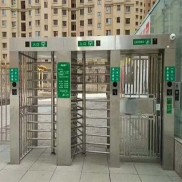 Dual Lane Tandem Full Height Turnstile Gate for Industry Park
Dual Lane Tandem Full Height Turnstile Gate for Industry Park
 Single Full Height Security Turnstile for Office Buildings
Single Full Height Security Turnstile for Office Buildings
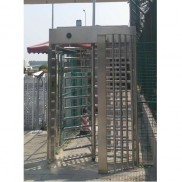 Motorised Double Full-Height Turnstile for Office Buildings
Motorised Double Full-Height Turnstile for Office Buildings








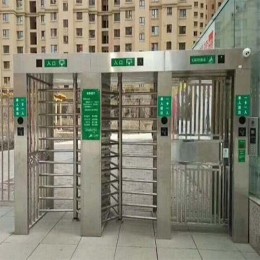







Please leave a message if you are interested in this model